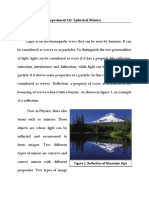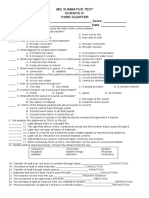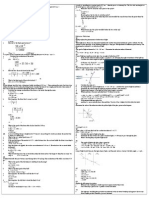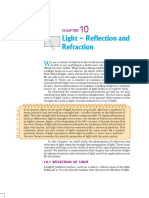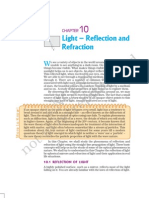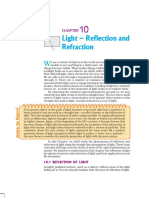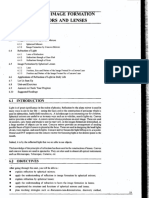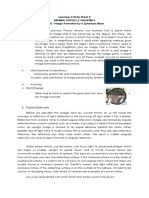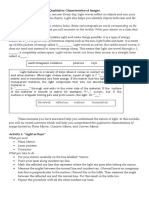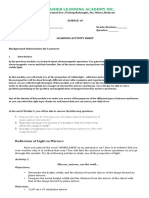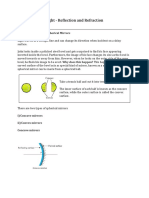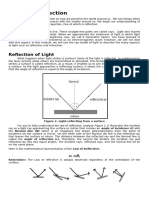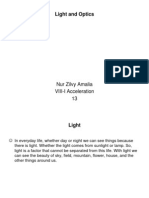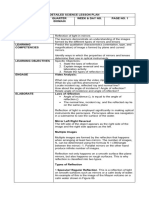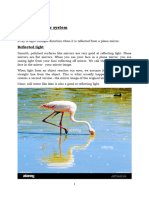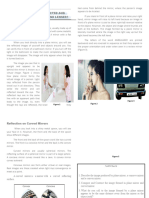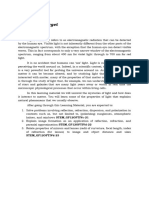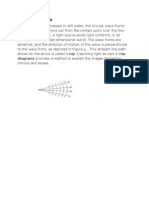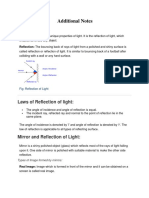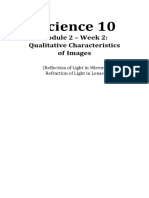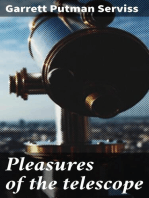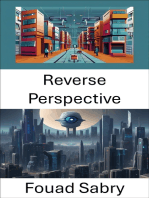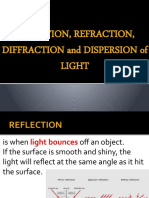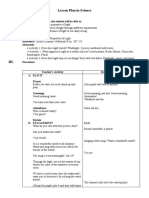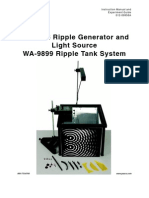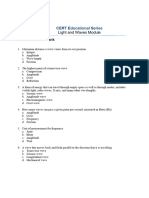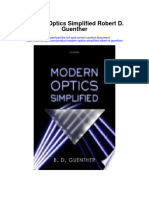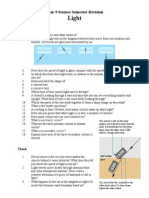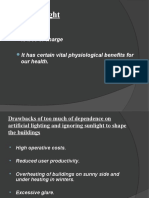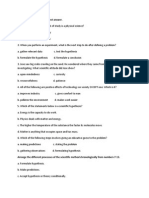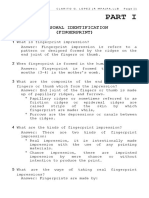Physics
Physics
Uploaded by
Lightning Ofiicial0 ratings0% found this document useful (0 votes)
17 views5 pagesCopyright
© © All Rights Reserved
Available Formats
DOCX, PDF, TXT or read online from Scribd
Share this document
Did you find this document useful?
Is this content inappropriate?
Report this DocumentCopyright:
© All Rights Reserved
Available Formats
Download as DOCX, PDF, TXT or read online from Scribd
Download as docx, pdf, or txt
0 ratings0% found this document useful (0 votes)
17 views5 pagesPhysics
Physics
Uploaded by
Lightning OfiicialCopyright:
© All Rights Reserved
Available Formats
Download as DOCX, PDF, TXT or read online from Scribd
Download as docx, pdf, or txt
You are on page 1of 5
CHAPTER9 We see a variety of objects in the world around us.
However, we are unable to see
anything in a dark room. On lighting up the room, things become visible. What makes things visible?
During the day, the sunlight helps us to see objects. An object reflects light that falls on it. This
reflected light, when received by our eyes, enables us to see things. We are able to see through a
transparent medium as light is transmitted through it. There are a number of common wonderful
phenomena associated with light such as image formation by mirrors, the twinkling of stars, the
beautiful colours of a rainbow, bending of light by a medium and so on. A study of the properties of
light helps us to explore them. By observing the common optical phenomena around us, we may
conclude that light seems to travel in straight lines. The fact that a small source of light casts a sharp
shadow of an opaque object points to this straight-line path of light, usually indicated as a ray of
light. More to Know! If an opaque object on the path of light becomes very small, light has a
tendency to bend around it and not walk in a straight line – an effect known as the diffraction of
light. Then the straight-line treatment of optics using rays fails. To explain phenomena such as
diffraction, light is thought of as a wave, the details of which you will study in higher classes. Again,
at the beginning of the 20th century, it became known that the wave theory of light often becomes
inadequate for treatment of the interaction of light with matter, and light often behaves somewhat
like a stream of particles. This confusion about the true nature of light continued for some years till a
modern quantum theory of light emerged in which light is neither a ‘wave’ nor a ‘particle’ – the new
theory reconciles the particle properties of light with the wave nature. In this Chapter, we shall study
the phenomena of reflection and refraction of light using the straight-line propagation of light. These
basic concepts will help us in the study of some of the optical phenomena in nature. We shall try to
understand in this Chapter the reflection of light by spherical mirrors and refraction of light and their
application in real life situations. 9.1 REFLECTION OF LIGHT A highly polished surface, such as a
mirror, reflects most of the light falling on it. You are already familiar with the laws of reflection of
light. Rationalised 2023-24 Light – Reflection and Refraction 135 Let us recall these laws – (i) The
angle of incidence is equal to the angle of reflection, and (ii) The incident ray, the normal to the
mirror at the point of incidence and the reflected ray, all lie in the same plane. These laws of
reflection are applicable to all types of reflecting surfaces including spherical surfaces. You are
familiar with the formation of image by a plane mirror. What are the properties of the image? Image
formed by a plane mirror is always virtual and erect. The size of the image is equal to that of the
object. The image formed is as far behind the mirror as the object is in front of it. Further, the image
is laterally inverted. How would the images be when the reflecting surfaces are curved? Let us
explore. Activity 9.1 n Take a large shining spoon. Try to view your face in its curved surface. n Do
you get the image? Is it smaller or larger? n Move the spoon slowly away from your face. Observe
the image. How does it change? n Reverse the spoon and repeat the Activity. How does the image
look like now? n Compare the characteristics of the image on the two surfaces. The curved surface of
a shining spoon could be considered as a curved mirror. The most commonly used type of curved
mirror is the spherical mirror. The reflecting surface of such mirrors can be considered to form a part
of the surface of a sphere. Such mirrors, whose reflecting surfaces are spherical, are called spherical
mirrors. We shall now study about spherical mirrors in some detail. 9.2 SPHERICAL MIRRORS The
reflecting surface of a spherical mirror may be curved inwards or outwards. A spherical mirror,
whose reflecting surface is curved inwards, that is, faces towards the centre of the sphere, is called a
concave mirror. A spherical mirror whose reflecting surface is curved outwards, is called a convex
mirror. The schematic representation of these mirrors is shown in Fig. 9.1. You may note in these
diagrams that the back of the mirror is shaded. You may now understand that the surface of the
spoon curved inwards can be approximated to a concave mirror and the surface of the spoon bulged
outwards can be approximated to a convex mirror. Before we move further on spherical mirrors, we
need to recognise and understand the meaning of a few terms. These terms are commonly used in
discussions about spherical mirrors. The centre of the reflecting surface of a spherical mirror is a
point called the pole. It lies on the surface of the mirror. The pole is usually represented by the letter
P. Figure 9.1 Schematic representation of spherical mirrors; the shaded side is non-reflecting. (a)
Concave mirror (b) Convex mirror Rationalised 2023-24 136 Science The reflecting surface of a
spherical mirror forms a part of a sphere. This sphere has a centre. This point is called the centre of
curvature of the spherical mirror. It is represented by the letter C. Please note that the centre of
curvature is not a part of the mirror. It lies outside its reflecting surface. The centre of curvature of a
concave mirror lies in front of it. However, it lies behind the mirror in case of a convex mirror. You
may note this in Fig.9.2 (a) and (b). The radius of the sphere of which the reflecting surface of a
spherical mirror forms a part, is called the radius of curvature of the mirror. It is represented by the
letter R. You may note that the distance PC is equal to the radius of curvature. Imagine a straight line
passing through the pole and the centre of curvature of a spherical mirror. This line is called the
principal axis. Remember that principal axis is normal to the mirror at its pole. Let us understand an
important term related to mirrors, through an Activity. Activity 9.2 CAUTION: Do not look at the Sun
directly or even into a mirror reflecting sunlight. It may damage your eyes. n Hold a concave mirror
in your hand and direct its reflecting surface towards the Sun. n Direct the light reflected by the
mirror on to a sheet of paper held close to the mirror. n Move the sheet of paper back and forth
gradually until you find on the paper sheet a bright, sharp spot of light. n Hold the mirror and the
paper in the same position for a few minutes. What do you observe? Why? The paper at first begins
to burn producing smoke. Eventually it may even catch fire. Why does it burn? The light from the
Sun is converged at a point, as a sharp, bright spot by the mirror. In fact, this spot of light is the
image of the Sun on the sheet of paper. This point is the focus of the concave mirror. The heat
produced due to the concentration of sunlight ignites the paper. The distance of this image from the
position of the mirror gives the approximate value of focal length of the mirror. Let us try to
understand this observation with the help of a ray diagram. Observe Fig.9.2 (a) closely. A number of
rays parallel to the principal axis are falling on a concave mirror. Observe the reflected rays. They are
all meeting/intersecting at a point on the principal axis of the mirror. This point is called the principal
focus of the concave mirror. Similarly, observe Fig. 9.2 (b). How are the rays parallel to the principal
axis, reflected by a convex mirror? The reflected rays appear to come from a point on the principal
axis. This point is called the principal focus of the convex mirror. The principal focus is represented
by the letter F. The distance between the pole and the principal focus of a spherical mirror is called
the focal length. It is represented by the letter f. Figure 9.2 (a) Concave mirror (b) Convex mirror (b)
(a) Rationalised 2023-24 Light – Reflection and Refraction 137 The reflecting surface of a spherical
mirror is by-and-large spherical. The surface, then, has a circular outline. The diameter of the
reflecting surface of spherical mirror is called its aperture. In Fig.9.2, distance MN represents the
aperture. We shall consider in our discussion only such spherical mirrors whose aperture is much
smaller than its radius of curvature. Is there a relationship between the radius of curvature R, and
focal length f, of a spherical mirror? For spherical mirrors of small apertures, the radius of curvature
is found to be equal to twice the focal length. We put this as R = 2f . This implies that the principal
focus of a spherical mirror lies midway between the pole and centre of curvature. 9.2.1 Image
Formation by Spherical Mirrors You have studied about the image formation by plane mirrors. You
also know the nature, position and relative size of the images formed by them. How about the
images formed by spherical mirrors? How can we locate the image formed by a concave mirror for
different positions of the object? Are the images real or virtual? Are they enlarged, diminished or
have the same size? We shall explore this with an Activity. Activity 9.3 You have already learnt a way
of determining the focal length of a concave mirror. In Activity 9.2, you have seen that the sharp
bright spot of light you got on the paper is, in fact, the image of the Sun. It was a tiny, real, inverted
image. You got the approximate focal length of the concave mirror by measuring the distance of the
image from the mirror. n Take a concave mirror. Find out its approximate focal length in the way
described above. Note down the value of focal length. (You can also find it out by obtaining image of
a distant object on a sheet of paper.) n Mark a line on a Table with a chalk. Place the concave mirror
on a stand. Place the stand over the line such that its pole lies over the line. n Draw with a chalk two
more lines parallel to the previous line such that the distance between any two successive lines is
equal to the focal length of the mirror. These lines will now correspond to the positions of the points
P, F and C, respectively. Remember – For a spherical mirror of small aperture, the principal focus F
lies mid-way between the pole P and the centre of curvature C. n Keep a bright object, say a burning
candle, at a position far beyond C. Place a paper screen and move it in front of the mirror till you
obtain a sharp bright image of the candle flame on it. n Observe the image carefully. Note down its
nature, position and relative size with respect to the object size. n Repeat the activity by placing the
candle – (a) just beyond C, (b) at C, (c) between F and C, (d) at F, and (e) between P and F. n In one of
the cases, you may not get the image on the screen. Identify the position of the object in such a
case. Then, look for its virtual image in the mirror itself. n Note down and tabulate your
observations. Rationalised 2023-24 138 Science You will see in the above Activity that the nature,
position and size of the image formed by a concave mirror depends on the position of the object in
relation to points P, F and C. The image formed is real for some positions of the object. It is found to
be a virtual image for a certain other position. The image is either magnified, reduced or has the
same size, depending on the position of the object. A summary of these observations is given for
your reference in Table 9.1. Table 9.1 Image formation by a concave mirror for different positions of
the object Position of the Position of the Size of the Nature of the object image image image At
infinity At the focus F Highly diminished, Real and inverted point-sized Beyond C Between F and C
Diminished Real and inverted At C At C Same size Real and inverted Between C and F Beyond C
Enlarged Real and inverted At F At infinity Highly enlarged Real and inverted Between P and F Behind
the mirror Enlarged Virtual and erect 9.2.2 Representation of Images Formed by Spherical Mirrors
Using Ray Diagrams We can also study the formation of images by spherical mirrors by drawing ray
diagrams. Consider an extended object, of finite size, placed in front of a spherical mirror. Each small
portion of the extended object acts like a point source. An infinite number of rays originate from
each of these points. To construct the ray diagrams, in order to locate the image of an object, an
arbitrarily large number of rays emanating from a point could be considered. However, it is more
convenient to consider only two rays, for the sake of clarity of the ray diagram. These rays are so
chosen that it is easy to know their directions after reflection from the mirror. The intersection of at
least two reflected rays give the position of image of the point object. Any two of the following rays
can be considered for locating the image. (i) A ray parallel to the principal axis, after reflection, will
pass through the principal focus in case of a concave mirror or appear to diverge from the principal
focus in case of a convex mirror. This is illustrated in Fig.9.3 (a) and (b). (a) (b) Figure 9.3 Rationalised
2023-24 Light – Reflection and Refraction 139 (ii) A ray passing through the principal focus of a
concave mirror or a ray which is directed towards the principal focus of a convex mirror, after
reflection, will emerge parallel to the principal axis. This is illustrated in Fig.9.4 (a) and (b). (iii) A ray
passing through the centre of curvature of a concave mirror or directed in the direction of the centre
of curvature of a convex mirror, after reflection, is reflected back along the same path. This is
illustrated in Fig.9.5 (a) and (b). The light rays come back along the same path because the incident
rays fall on the mirror along the normal to the reflecting surface. (iv) A ray incident obliquely to the
principal axis, towards a point P (pole of the mirror), on the concave mirror [Fig. 9.6 (a)] or a convex
mirror [Fig. 9.6 (b)], is reflected obliquely. The incident and reflected rays follow the laws of
reflection at the point of incidence (point P), making equal angles with the principal axis. (a) (b)
Figure 9.4 Remember that in all the above cases the laws of reflection are followed. At the point of
incidence, the incident ray is reflected in such a way that the angle of reflection equals the angle of
incidence. (a) Image formation by Concave Mirror Figure 9.7 illustrates the ray diagrams for the
formation of image by a concave mirror for various positions of the object. (b) (a) Figure 9.5 (a) (b)
Figure 9.6 Rationalised 2023-24 140 Science Figure 9.7 Ray diagrams for the image formation by a
concave mirror Activity 9.4 n Draw neat ray diagrams for each position of the object shown in Table
9.1. n You may take any two of the rays mentioned in the previous section for locating the image. n
Compare your diagram with those given in Fig. 9.7. n Describe the nature, position and relative size
of the image formed in each case. n Tabulate the results in a convenient format. Uses of concave
mirrors Concave mirrors are commonly used in torches, search-lights and vehicles headlights to get
powerful parallel beams of light. They are often used as shaving mirrors to see a larger image of the
face. The dentists use concave mirrors to see large images of the teeth of patients. Large concave
mirrors are used to concentrate sunlight to produce heat in solar furnaces. (b) Image formation by a
Convex Mirror We studied the image formation by a concave mirror. Now we shall study the
formation of image by a convex mirror. Rationalised 2023-24 Light – Reflection and Refraction 141
We consider two positions of the object for studying the image formed by a convex mirror. First is
when the object is at infinity and the second position is when the object is at a finite distance from
the mirror. The ray diagrams for the formation of image by a convex mirror for these two positions
of the object are shown in Fig.9.8 (a) and (b), respectively. The results are summarised in Table 9.2.
Activity 9.5 n Take a convex mirror. Hold it in one hand. n Hold a pencil in the upright position in the
other hand. n Observe the image of the pencil in the mirror. Is the image erect or inverted? Is it
diminished or enlarged? n Move the pencil away from the mirror slowly. Does the image become
smaller or larger? n Repeat this Activity carefully. State whether the image will move closer to or
farther away from the focus as the object is moved away from the mirror? Figure 9.8 Formation of
image by a convex mirror You have so far studied the image formation by a plane mirror, a concave
mirror and a convex mirror. Which of these mirrors will give the full image of a large object? Let us
explore through an Activity. Activity 9.6 n Observe the image of a distant object, say a distant tree, in
a plane mirror. n Could you see a full-length image? Table 9.2 Nature, position and relative size of
the image formed by a convex mirror Position of the Position of the Size of the Nature of the object
image image image At infinity At the focus F, Highly diminished, Virtual and erect behind the mirror
point-sized Between infinity Between P and F, Diminished Virtual and erect and the pole P of behind
the mirror the mirror Rationalised 2023-24 142 Science n Try with plane mirrors of different sizes.
Did you see the entire object in the image? n Repeat this Activity with a concave mirror. Did the
mirror show full length image of the object? n Now try using a convex mirror. Did you succeed?
Explain your observations with reason. You can see a full-length image of a tall building/tree in a
small convex mirror. One such mirror is fitted in a wall of Agra Fort facing Taj Mahal. If you visit the
Agra Fort, try to observe the full image of Taj Mahal. To view distinctly, you should stand suitably at
the terrace adjoining the wall. Uses of convex mirrors Convex mirrors are commonly used as rear-
view (wing) mirrors in vehicles. These mirrors are fitted on the sides of the vehicle, enabling the
driver to see traffic behind him/her to facilitate safe driving. Convex mirrors are preferred because
they always give an erect, though diminished, image. Also, they have a wider field of view as they
are curved outwards. Thus, convex mirrors enable the driver to view much larger area than would be
possible with a plane mirror. QUESTIONS ? 1. Define the principal focus of a concave mirror. 2. The
radius of curvature of a spherical mirror is 20 cm. What is its focal length? 3. Name a mirror that can
give an erect and enlarged image of an object. 4. Why do we prefer a convex mirror as a rear-view
mirror in vehicles? 9.2.3 Sign Convention for Reflection by Spherical Mirrors While dealing with the
reflection of light by spherical mirrors, we shall follow a set of sign conventions called the New
Cartesian Sign Convention. In this convention, the pole (P) of the mirror is taken as the origin (Fig.
9.9). The principal axis of the mirror is taken as the x-axis (X’X) of the coordinate system. The
conventions are as follows – (i) The object is always placed to the left of the mirror. This implies that
the light from the object falls on the mirror from the left-hand side. (ii) All distances parallel to the
principal axis are measured from the pole of the mirror. (iii) All the distances measured to the right
of the origin (along + x-axis) are taken as positive while those measured to the left of the origin
(along – x-axis) are taken as negative. (iv) Distances measured perpendicular to and above the
principal axis (along + y-axis) are taken as positive. (v) Distances measured perpendicular to and
below the principal axis (along –y-axis) are taken as negative. Rationalised 2023-24 Light – Reflection
and Refraction 143 The New Cartesian Sign Convention described above is illustrated in Fig.9.9 for
your reference. These sign conventions are applied to obtain the mirror formula and solve related
numerical problems. 9.2.4 Mirror Formula and Magnification In a spherical mirror, the distance of
the object from its pole is called the object distance (u). The distance of the image from the pole of
the mirror is called the image distance (v). You already know that the distance of the principal focus
from the pole is called the focal length (f). There is a relationship between these three quantities
given by the mirror formula which is expressed as 1 1 1 v u f + = (9.1) This formula is valid in all
situations for all spherical mirrors for all positions of the object. You must use the New Cartesian
Sign Convention while substituting numerical values for u, v, f, and R in the mirror formula for
solving problems. Magnification Magnification produced by a spherical mirror gives the relative
extent to which the image of an object is magnified with respect to the object size. It is expressed as
the ratio of the height of the image to the height of the object. It is usually represented by the letter
m. If h is the height of the object and h′ is the height of the image, then the magnification m
produced by a spherical mirror is given by m = Height of the image ( ) Height of the object ( ) h′ h m =
h′ h (9.2) The magnification m is also related to the object distance (u) and image distance (v). It can
be expressed as: Magnification (m) = ′ = − h h v u (9.3) You may note that the height of the object is
taken to be positive as the object is usually placed above the principal axis. The height of the image
should be taken as positive for virtual images. However, it is to be taken as negative for real images.
A negative sign in the value of the magnification indicates that the image is real. A positive sign in
the value of the magnification indicates that the image is virtual. Figure 9.9 The New Cartesian Sign
Convention for spherical mirrors Rationalised 2023-24 144 Science Example 9.1 A convex mirror
used for rear-view on an automobile has a radius of curvature of 3.00 m. If a bus is located at 5.00 m
from this mirror, find the position, nature and size of the image. Solution Radius of curvature, R = +
3.00 m; Object-distance, u = – 5.00 m; Image-distance, v = ? Height of the image, h′= ? Focal length, f
= R/2 = + 3.00 m 2 = + 1.50 m (as the principal focus of a convex mirror is behind the mirror) Since 1
1 1 + = v u f or, 1 1 1 v f u = − = + 1 1.50 – 1 ( 5.00) − = 1 1.50 + 1 5.00 = 5.00 1.50 7.50 + v = 7.50 6.50
+ = + 1.15 m The image is 1.15 m at the back of the mirror. Magnification, m = h v ' h u = − = – 1.15 m
−5.00 m = + 0.23 The image is virtual, erect and smaller in size by a factor of 0.23. Example 9.2 An
object, 4.0 cm in size, is placed at 25.0 cm in front of a concave mirror of focal length 15.0 cm. At
what distance from the mirror should a screen be placed in order to obtain a sharp image? Find the
nature and the size of the image. Solution Object-size, h = + 4.0 cm; Object-distance, u = – 25.0 cm;
Focal length, f = –15.0 cm; Image-distance, v = ? Image-size, h′ = ? From Eq. (10.1): 1 1 1 v u f + = or, 1
1 1 v f u = − = 1 1 1 1 15.0 25.0 15.0 25.0 − = − + − − Rationalised 2023-24 Light – Reflection and
Refraction 145 or, 1 5.0 3.0 2.0 v 75.0 75.0 − + − = = or, v = – 37.5 cm The screen should be placed at
37.5 cm in front of the mirror. The image is real. Also, magnification, m = h v ' h u = − or, h′ = – v h u =
( 37.5cm) ( 4.0cm) ( 25.0 cm) − + − − Height of the image, h′ = – 6.0 cm The image is inverted and
enlarged.
You might also like
- E111 - AgustinDocument20 pagesE111 - AgustinSeth Jarl G. AgustinNo ratings yet
- (#2) Summative Test Science Iv Third Quarter Name: - Score: - Grade/Section: - DateDocument1 page(#2) Summative Test Science Iv Third Quarter Name: - Score: - Grade/Section: - DateChristianGalangDelFin100% (7)
- Subject Link 9 WBDocument20 pagesSubject Link 9 WBJasmine BarrettNo ratings yet
- Equations of Motion Worksheet Cheat ShheetDocument5 pagesEquations of Motion Worksheet Cheat Shheetrondo101No ratings yet
- PV 2501 enDocument14 pagesPV 2501 enKmilo VinaTea ChavezNo ratings yet
- Refraction of LightDocument27 pagesRefraction of LighttejassidhpuraNo ratings yet
- Jesc110 PDFDocument27 pagesJesc110 PDFAlexander ChavezNo ratings yet
- CBSE Class X Science CH 10 Light - Reflection and Refraction Part 1Document18 pagesCBSE Class X Science CH 10 Light - Reflection and Refraction Part 1Saumil S. SharmaNo ratings yet
- PhysicsDocument27 pagesPhysicselitation985No ratings yet
- Physics PDFDocument27 pagesPhysics PDFSamita MariyaNo ratings yet
- 10 - 10 Light Reflection and RefractionDocument33 pages10 - 10 Light Reflection and RefractionSharmila BegumNo ratings yet
- Untitled2 ProjectDocument27 pagesUntitled2 ProjectPreeti RaniNo ratings yet
- Jesc110 1 PDFDocument27 pagesJesc110 1 PDFMvNo ratings yet
- Light Reflection and RefractionDocument27 pagesLight Reflection and RefractionKumar ShantanuNo ratings yet
- Ch-9 Light Reflection& RefractionDocument176 pagesCh-9 Light Reflection& Refractiontanayarora5890No ratings yet
- Properties of LightDocument10 pagesProperties of LightKesanam SpNo ratings yet
- Light Mirrors and LensesDocument28 pagesLight Mirrors and LensesJohn Malig100% (1)
- CBSE Class 7 Science Chapter 15 Light Revision NotesDocument28 pagesCBSE Class 7 Science Chapter 15 Light Revision NotesPRATUL SINGHNo ratings yet
- Capstone ProjectDocument29 pagesCapstone ProjectJohn RemzNo ratings yet
- Unit 6Document33 pagesUnit 6mirdulsahuNo ratings yet
- Sci10 Module 2 (Q2-Week 6-8)Document12 pagesSci10 Module 2 (Q2-Week 6-8)Chris John SantosNo ratings yet
- Reflection of Light in MirrorsDocument16 pagesReflection of Light in Mirrorskimberly.tanoNo ratings yet
- Optics Hand OutDocument14 pagesOptics Hand OutChillyung OxytoneNo ratings yet
- Reflection of LightDocument17 pagesReflection of LightNishant SinghNo ratings yet
- Physical Science Q4 Week 5 v2Document21 pagesPhysical Science Q4 Week 5 v2Jojie Sumayang-Golisao100% (1)
- CH 1 PhysicsDocument18 pagesCH 1 Physicsraj chopdaNo ratings yet
- Learning Activity Sheet 4 q4 and ST 2Document14 pagesLearning Activity Sheet 4 q4 and ST 2Daniel Angelo Esquejo ArangoNo ratings yet
- Qualitative Characteristics of Images: Absorbed Reflection Scatters TransmittedDocument6 pagesQualitative Characteristics of Images: Absorbed Reflection Scatters TransmittedMira VeranoNo ratings yet
- GRADE 10 - SCIENCE Notes 3 (2nd Quarter)Document3 pagesGRADE 10 - SCIENCE Notes 3 (2nd Quarter)gwenn enaje100% (1)
- Buenasher Learning Academy Inc.: Km.39 Cityland Ave., Pulong Buhangin, Sta. Maria, BulacanDocument9 pagesBuenasher Learning Academy Inc.: Km.39 Cityland Ave., Pulong Buhangin, Sta. Maria, BulacanEl CruzNo ratings yet
- XJHNZDMZ NHD Ahw AYag 3 RDocument38 pagesXJHNZDMZ NHD Ahw AYag 3 RVenu GopalNo ratings yet
- Light (Mirrors and Lenses)Document19 pagesLight (Mirrors and Lenses)allijah gwyneth dalesNo ratings yet
- Physical Science Module Reflection of LightDocument3 pagesPhysical Science Module Reflection of LightibemaristelleNo ratings yet
- Light and OpticsDocument24 pagesLight and OpticsZilvy Amalia NurNo ratings yet
- Chapter-10 Light Final - Ejrm4pw4gjcvtmnndtktDocument17 pagesChapter-10 Light Final - Ejrm4pw4gjcvtmnndtktSarveshyaNo ratings yet
- Jesc110 18Document1 pageJesc110 18Bharat SalunkheNo ratings yet
- Light EnergyDocument5 pagesLight Energyammarahn0No ratings yet
- Wave and Optics DLPDocument8 pagesWave and Optics DLPlopezchinshin28No ratings yet
- Chapter-12 Geometrical OpticsDocument8 pagesChapter-12 Geometrical OpticsKashif FazalNo ratings yet
- 10th Physics Chapter 10.light-Reflection and Refraction NotesDocument39 pages10th Physics Chapter 10.light-Reflection and Refraction NotesTapas Banerjee100% (4)
- Learning Plan in Science 10: Unit Topic: Content Standard: Learning CompetenciesDocument13 pagesLearning Plan in Science 10: Unit Topic: Content Standard: Learning Competenciesakoaysijoy100% (1)
- Physics 122Document107 pagesPhysics 122stephenalfa7No ratings yet
- Reflection: Light - Reflection and RefractionDocument11 pagesReflection: Light - Reflection and RefractionmathclubNo ratings yet
- Grade 6 Chapter 6 NoteDocument4 pagesGrade 6 Chapter 6 NotesiyaNo ratings yet
- 25 Activity MirrorsDocument4 pages25 Activity MirrorsJenny BayengNo ratings yet
- Physics Class X For 2017 18 5 42Document38 pagesPhysics Class X For 2017 18 5 42jatinder kohliNo ratings yet
- SCIENCE10 Q2 M4 LightsMirrorsandLenses v3-EDITEDDocument22 pagesSCIENCE10 Q2 M4 LightsMirrorsandLenses v3-EDITEDRusty Gabriel Suyom100% (1)
- Reviewer For The Types of Mirrors and Lenses and Their PropertiesDocument10 pagesReviewer For The Types of Mirrors and Lenses and Their Propertiestrinidadsean2008No ratings yet
- Physics 2 Week4Document19 pagesPhysics 2 Week4basurahangyujNo ratings yet
- NMAT Reviewer Geometrical OpticsDocument37 pagesNMAT Reviewer Geometrical Opticsmannypot83% (12)
- Science 10 - Week 16Document6 pagesScience 10 - Week 16Mira VeranoNo ratings yet
- Mirrors and LensesDocument28 pagesMirrors and LensesRemi Eyonganyoh100% (1)
- Reflection and Refraction of Mirrors-1Document47 pagesReflection and Refraction of Mirrors-1ogohjusticeNo ratings yet
- Chapter - 10 (A) Light and ReflectionDocument12 pagesChapter - 10 (A) Light and ReflectionSuhani Gosain100% (1)
- Additional Notes - LightDocument10 pagesAdditional Notes - LightsidharthNo ratings yet
- Science10 Q2 Mod3 QualitativeCharacteristicsOfImagesDocument12 pagesScience10 Q2 Mod3 QualitativeCharacteristicsOfImagesKOBE BRYANT TIDOYNo ratings yet
- Light and Shade: A Classic Approach to Three-Dimensional DrawingFrom EverandLight and Shade: A Classic Approach to Three-Dimensional DrawingRating: 4 out of 5 stars4/5 (8)
- Pleasures of the telescope: An Illustrated Guide for Amateur Astronomers and a Popular Description of the Chief Wonders of the Heavens for General ReadersFrom EverandPleasures of the telescope: An Illustrated Guide for Amateur Astronomers and a Popular Description of the Chief Wonders of the Heavens for General ReadersNo ratings yet
- I Can See Planets and Stars from My Room! How The Telescope Works - Physics Book 4th Grade | Children's Physics BooksFrom EverandI Can See Planets and Stars from My Room! How The Telescope Works - Physics Book 4th Grade | Children's Physics BooksNo ratings yet
- Cylindrical Perspective: Cylindrical Perspective: Exploring Visual Perception in Computer VisionFrom EverandCylindrical Perspective: Cylindrical Perspective: Exploring Visual Perception in Computer VisionNo ratings yet
- Reverse Perspective: Reimagining Visual Perception in Computer VisionFrom EverandReverse Perspective: Reimagining Visual Perception in Computer VisionNo ratings yet
- ICO Residency-Curriculum PDFDocument219 pagesICO Residency-Curriculum PDFJujunNo ratings yet
- Reflection, Refraction, Diffraction and Dispersion of LightDocument24 pagesReflection, Refraction, Diffraction and Dispersion of LightChristian DeanNo ratings yet
- Physics 200Document51 pagesPhysics 200heru2910No ratings yet
- Lesson Plan in ScienceDocument3 pagesLesson Plan in ScienceGeovilyn ManglallanNo ratings yet
- UT General ExamDocument25 pagesUT General ExamMohamed Ibrahim100% (1)
- Bphys102 Mod1 5azdocuments - in 1 25Document25 pagesBphys102 Mod1 5azdocuments - in 1 25Ireneus RodriguesNo ratings yet
- Hess 101Document906 pagesHess 101BalaRajKumarNo ratings yet
- Chapter 8 - Illumination Models & Surface-Rendering MethodsDocument45 pagesChapter 8 - Illumination Models & Surface-Rendering MethodsTanveer Ahmed HakroNo ratings yet
- Pigmentos PerlescentesDocument20 pagesPigmentos PerlescentesMiguelAlegriaNo ratings yet
- RN1 PDFDocument2 pagesRN1 PDFjp9bmf29hdNo ratings yet
- Lesson 4.1 Properties of Light 2022Document23 pagesLesson 4.1 Properties of Light 2022Dainiel G. PerezNo ratings yet
- Invisible Radiations of Organisms by Otto RahnDocument225 pagesInvisible Radiations of Organisms by Otto RahnIvan Roca100% (1)
- Concertina ReedsDocument9 pagesConcertina ReedslashgvashNo ratings yet
- Pasco Ripple Tank ManualDocument31 pagesPasco Ripple Tank ManualMuhammad UsmanNo ratings yet
- Summer Break Work of Physics For Class 12Document4 pagesSummer Break Work of Physics For Class 12pammi.radhakrishna.0743No ratings yet
- Light QuizDocument5 pagesLight QuizThene Truthe NoweNo ratings yet
- BJ - Cable Type - EN - TCD210042AA - CATALOG - WDocument2 pagesBJ - Cable Type - EN - TCD210042AA - CATALOG - WJORGE RODNo ratings yet
- Modern Optics Simplified Robert D Guenther Full ChapterDocument67 pagesModern Optics Simplified Robert D Guenther Full Chapterwallace.massey637100% (22)
- ElectrostaticsDocument47 pagesElectrostaticsKaran JeetNo ratings yet
- X-Ray Reflectivity Studies of Thin FilmDocument9 pagesX-Ray Reflectivity Studies of Thin Filmarpon32100% (2)
- Light: Year 9 Science Semester RevisionDocument4 pagesLight: Year 9 Science Semester Revisionapi-32133818No ratings yet
- LightDocument68 pagesLightAmita MaddhesiyaNo ratings yet
- Write Only The Letter of The Best AnswerDocument10 pagesWrite Only The Letter of The Best AnswerKia BaluyutNo ratings yet
- G26587 Vijay KumarDocument236 pagesG26587 Vijay KumarLaxmikant ManeNo ratings yet
- Criminalistics 1 PDFDocument105 pagesCriminalistics 1 PDFKARLVIN50% (2)
- Bolleballi Naganivrithi (Greendaless) - Sec 1 Summary NotesDocument12 pagesBolleballi Naganivrithi (Greendaless) - Sec 1 Summary NotesB.NiviNo ratings yet
